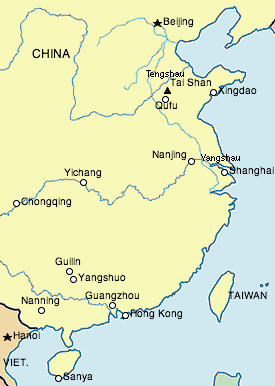Yangshau
Monday, December 6th, 2004
Currently in a delightful city (Yangshau) that is on the Yangtze River about 100 miles north of Shanghai.
China’s autumn has been fantastic, the people interesting (and challanging) and the food tasty (most of the time) even if we do not always know what we are eating.
Spent 3 days north of Beijing trekking the Great Wall (I waved to the folks in space so hopefully they were able to see me) and then did a couple of climbs on China’s sacred mountains (Tai Shan and Lao Shan).
The climbs were more like our day hikes in Oregon but still a good workout–spent one night on the summit and got up with several hundred Chinese to view the sunrise–magical and mystical as an orange globe emerging from a cloud bank. The Chinese, however, take a tram to the summit and were quite surprised that a foreigner of my age would want to walk up the mountain. “Singjingbing” (“crazy”) is the frequently heard comment.
China is a very dynamic country and going through rapid metamorphoses–in 10 yrs it will be quite different and maybe not for the better–they aim for modernization and construction is booming. However on the lanes, streets and freeways autos compete with pedestrians, bikes, and hand drawn/animal drawn carts. The expression “Chinese fire drill” prevails. Crossing a street is an adventure.
Market economy is obvious and pervasive–Karl Marx can only be shaking his head.
Tiz OK to laugh with the Chinese but not at them (have made a couple of social/cultural guffaws).
Off the tourist track we foreigners are still an oddity and draw many long stares. Younger children say “hello” and then giggle. I say “neehow” (hello) and they giggle even more. The smaller kids are cute as can be; as they get older (teens) jeans and cell phones prevail and there is the loss of cultural diversity.
Air pollution, autos, hacking & spitting, littering (everything: restaurant bones, trash, spit goes on the floor–at an internet cafe I was admonished by the propriator for putting my backpack on the floor–did not appreciate her concern until I realized what all else is on the floor and had the insight that she was trying to prevent backpack contamination.)
Then the Chinese sweep–everywhere things are swept with grass brooms but that is as deep as the cleaning process goes. But as always the fun is in observing and appreciating cultural differences (a two way street as they laugh at me)
later. B

